
Documentation
BX8000
Bus Terminal Controller for RS232/RS485
2.1.0
2019-06-14
Version:
Date:


Table of contents
BX8000 3Version: 2.1.0
Table of contents
1 Foreword ....................................................................................................................................................5
1.1 Notes on the documentation..............................................................................................................5
1.2 Safety instructions .............................................................................................................................6
1.3 Documentation issue status ..............................................................................................................7
2 Product overview.......................................................................................................................................8
2.1 Bus Terminal Controllers of the BX series.........................................................................................8
2.2 Introduction......................................................................................................................................10
2.3 The principle of the Bus Terminal....................................................................................................11
2.4 The Beckhoff Bus Terminal system.................................................................................................11
2.5 Technical data .................................................................................................................................13
2.5.1 Technical data - BX ......................................................................................................... 13
2.5.2 Technical Data - PLC....................................................................................................... 15
3 Mounting and wiring................................................................................................................................16
3.1 Mounting..........................................................................................................................................16
3.1.1 Dimensions ...................................................................................................................... 16
3.1.2 Installation on mounting rails ........................................................................................... 17
3.2 Wiring...............................................................................................................................................18
3.2.1 Potential groups, insulation testing and PE ..................................................................... 18
3.2.2 Power supply ................................................................................................................... 20
3.2.3 Programming cable for COM1 ......................................................................................... 22
3.2.4 SSB and COM interface .................................................................................................. 23
4 Parameterization and Commissioning ..................................................................................................25
4.1 Start-up behavior of the Bus Terminal Controller ............................................................................25
4.2 Configuration ...................................................................................................................................26
4.2.1 Overview.......................................................................................................................... 26
4.2.2 Creating a TwinCAT configuration................................................................................... 28
4.2.3 Downloading a TwinCAT configuration............................................................................ 28
4.2.4 Uploading a TwinCAT configuration ................................................................................ 30
4.2.5 Resources in the Bus Terminal Controller ....................................................................... 32
4.2.6 ADS connection via serial interface ................................................................................. 34
4.2.7 K-bus ............................................................................................................................... 36
4.2.8 PLC.................................................................................................................................. 38
4.2.9 SSB.................................................................................................................................. 41
4.2.10 Real-Time Clock (RTC) ................................................................................................... 72
4.2.11 COM port ......................................................................................................................... 73
4.3 Menu................................................................................................................................................74
4.3.1 BX menu settings............................................................................................................. 74
4.3.2 Creating own menus........................................................................................................ 78
4.4 Configuration software KS2000.......................................................................................................78
5 Programming ...........................................................................................................................................80
5.1 PLC features of the BX controllers ..................................................................................................80
5.2 TwinCAT PLC..................................................................................................................................80
5.3 Allocated flags .................................................................................................................................81

Table of contents
BX80004 Version: 2.1.0
5.4 Remanent data ................................................................................................................................81
5.5 Persistent data.................................................................................................................................82
5.6 Local process image in delivery state (default config).....................................................................83
5.7 TwinCAT PLC - Error codes ............................................................................................................85
5.8 Mapping the Bus Terminals.............................................................................................................87
5.9 Local process image in the TwinCAT configuration ........................................................................88
5.10 Creating a boot project ....................................................................................................................89
5.11 Communication between TwinCAT and BX/BCxx50.......................................................................89
5.12 Up- and downloading of programs ..................................................................................................91
5.13 Libraries...........................................................................................................................................94
5.13.1 Libraries overview............................................................................................................ 94
5.13.2 TcBaseBX........................................................................................................................ 97
5.13.3 TcSystemBX .................................................................................................................. 109
5.13.4 TcComPortBX................................................................................................................ 112
5.13.5 TcTwinSAFE.................................................................................................................. 122
5.14 Program transfer via the serial interface........................................................................................129
6 Error handling and diagnosis...............................................................................................................131
6.1 Diagnostics ....................................................................................................................................131
6.2 Diagnostic LEDs ............................................................................................................................131
6.3 Diagnostics display........................................................................................................................135
7 Appendix ................................................................................................................................................136
7.1 Switching between controllers .......................................................................................................136
7.2 Firmware Update ...........................................................................................................................138
7.3 CFC-Client*....................................................................................................................................140
7.4 Sample programs - overview.........................................................................................................143
7.5 General operating conditions.........................................................................................................143
7.6 Test standards for device testing...................................................................................................145
7.7 Support and Service ......................................................................................................................146

Foreword
BX8000 5Version: 2.1.0
1 Foreword
1.1 Notes on the documentation
Intended audience
This description is only intended for the use of trained specialists in control and automation engineering who
are familiar with the applicable national standards.
It is essential that the documentation and the following notes and explanations are followed when installing
and commissioning these components.
It is the duty of the technical personnel to use the documentation published at the respective time of each
installation and commissioning.
The responsible staff must ensure that the application or use of the products described satisfy all the
requirements for safety, including all the relevant laws, regulations, guidelines and standards.
Disclaimer
The documentation has been prepared with care. The products described are, however, constantly under
development.
We reserve the right to revise and change the documentation at any time and without prior announcement.
No claims for the modification of products that have already been supplied may be made on the basis of the
data, diagrams and descriptions in this documentation.
Trademarks
Beckhoff
®
, TwinCAT
®
, EtherCAT
®
, EtherCATP
®
, SafetyoverEtherCAT
®
, TwinSAFE
®
, XFC
®
and XTS
®
are
registered trademarks of and licensed by Beckhoff Automation GmbH.
Other designations used in this publication may be trademarks whose use by third parties for their own
purposes could violate the rights of the owners.
Patent Pending
The EtherCAT Technology is covered, including but not limited to the following patent applications and
patents: EP1590927, EP1789857, DE102004044764, DE102007017835 with corresponding applications or
registrations in various other countries.
The TwinCAT Technology is covered, including but not limited to the following patent applications and
patents: EP0851348, US6167425 with corresponding applications or registrations in various other countries.
EtherCAT
®
is registered trademark and patented technology, licensed by Beckhoff Automation GmbH,
Germany.
Copyright
© Beckhoff Automation GmbH & Co. KG, Germany.
The reproduction, distribution and utilization of this document as well as the communication of its contents to
others without express authorization are prohibited.
Offenders will be held liable for the payment of damages. All rights reserved in the event of the grant of a
patent, utility model or design.

Foreword
BX80006 Version: 2.1.0
1.2 Safety instructions
Safety regulations
Please note the following safety instructions and explanations!
Product-specific safety instructions can be found on following pages or in the areas mounting, wiring,
commissioning etc.
Exclusion of liability
All the components are supplied in particular hardware and software configurations appropriate for the
application. Modifications to hardware or software configurations other than those described in the
documentation are not permitted, and nullify the liability of Beckhoff Automation GmbH & Co. KG.
Personnel qualification
This description is only intended for trained specialists in control, automation and drive engineering who are
familiar with the applicable national standards.
Description of instructions
In this documentation the following instructions are used.
These instructions must be read carefully and followed without fail!
DANGER
Serious risk of injury!
Failure to follow this safety instruction directly endangers the life and health of persons.
WARNING
Risk of injury!
Failure to follow this safety instruction endangers the life and health of persons.
CAUTION
Personal injuries!
Failure to follow this safety instruction can lead to injuries to persons.
NOTE
Damage to environment/equipment or data loss
Failure to follow this instruction can lead to environmental damage, equipment damage or data loss.
Tip or pointer
This symbol indicates information that contributes to better understanding.

Foreword
BX8000 7Version: 2.1.0
1.3 Documentation issue status
Version Modifications
2.1.0 • Download links updated
• Design of safety instructions adapted to IEC 82079-1.
2.0.0 • Migration
1.2.0 • Update to firmware version 1.20
1.1.7 • Update to firmware version 1.17
1.1.6 • Update to firmware version 1.16
1.1.4 • Update to firmware version 1.14
1.1.2 • Update to firmware version 1.12
Firmware BX8000
The BX Controller displays its firmware version for about 3 seconds when it is switched on.
For updating your firmware you need a serial cable, the KS2000 configuration software, or the firmware
update program.
Firmware Description
1.22 • Optimization of the COM 2 interface in RS485 mode when using 2 stop bits
1.20 • Switching of the COM 2 interface between RS232 and RS485 modified
ATTENTION
The software 1.20 is not executable on older hardware versions (lower than 3.5). Please take the
hardware version of your BX Controller from its sticker
1.17 • Support for TwinSAFE Bus Terminals, maximally one logic terminal with a maximum of 7
connections allowed on the K-bus
• New: Support of persistent data
• Forcing and reading of the TwinCAT configuration corrected
• CFC tool is supported as in firmware 1.14 and lower
1.16 • Online change problem rectified for large projects
• New: Display backlight can be switched off
• New: Boot project CRC display can be enabled during booting
• REAL_TO_STRING: in the case of Real variables with, for example, 9.0, this is now also
output as a string beforehand ‚9.’
• TC-Config: 4-way and 8-way analog terminals fixed
1.14 • K-bus updated
• SSB reset of the SSB implemented
• Generic function implemented
• Non-implemented features are disabled with the System Manager, build 1303.
• Writing of outputs is possible with TwinCAT Build 1302
• Optimization of the terminal verification in a TwinCAT configuration
1.12 • The TC-Config supports KL1212
• The TC-Config supports KM modules

Product overview
BX80008 Version: 2.1.0
2 Product overview
2.1 Bus Terminal Controllers of the BX series
Fig.1: Bus Terminal Controllers of the BX series
The Bus Terminal Controllers of the BX series (BX controllers) offer a high degree of flexibility. In terms of
the equipment and performance range, the BX series is positioned between the BC series Bus Terminal
controller and the CX1000 Embedded PC. The concept of a stand-alone controller in combination with a link
to a higher-level fieldbus system is based on the BC series. The housing design originates from the CX1000.
The main features distinguishing the BC and BX series are the larger memory and the expanded interfaces
of the BX series.
The BX controllers consist of a programmable IEC61131-3 controller, a connection to the higher-level
fieldbus system and the K-bus interface for connecting the Beckhoff Bus Terminals. In addition, the BX
controllers have two serial interfaces: one for programming, the other for free utilization. The device itself
includes an illuminated LC display (2 rows with 16 characters each) with joystick switch and a real-time
clock. Further peripheral devices, e.g.displays, can be connected via the integrated Beckhoff Smart System
Bus (SSB).
The Bus Terminals are connected on the right side of the BX controller, as usual. The comprehensive range
of different I/Os enables any input signal to be read and any output signal that may be required to be
generated. The BX controllers can be used for a wide range of automation tasks, from garage door control to
autonomous temperature control at injection molding machines. The BX controllers are also eminently
suitable for a modular machine concept. Within a network, the BX controllers can exchange data with other
machine components via the fieldbus interfaces. The real-time clock also enables decentralized applications,
for which the day of the week or the time play an important role.
The areas of application of this series are similar to that of the BC series, but due to the larger memory the
BX can execute significantly more complex and larger programs and can manage more data locally
(e.g.history and trend data recording), which are then successively fetched over the fieldbus.
Bus Terminal and end terminal required
To operate a BX controller, at least one Bus Terminal with process image and the end terminal
must be connected to its K-bus.
Fieldbus interface
The variants of the BX series Bus Terminal Controllers differ in terms of their fieldbus interfaces. Additionally,
two serial interfaces are integrated for programming and for the connection of further serial devices. Five
different versions cover the main fieldbus systems:
• BX3100: PROFIBUS DP

Product overview
BX8000 9Version: 2.1.0
• BX5100: CANopen
• BX5200: DeviceNet
• BX8000: RS232 or RS485 (without fieldbus interface)
• BX9000: Ethernet ModbusTCP/ADS-TCP/UDP
Programming
The BX controllers are programmed based on the effective IEC 61131-3 standard. As with all other Beckhoff
controllers, the TwinCAT automation software is the basis for parameterization and programming. Users
therefore have the familiar TwinCAT tools available, e.g.PLC programming interface, System Manager and
TwinCAT Scope. Data is exchanged optionally via the serial port (COM1) or via the fieldbus through
Beckhoff PC FCxxxx fieldbus cards.
Configuration
The configuration is also carried out using TwinCAT. The fieldbus interface, the SSB bus and the real-time
clock can be configured and parameterized via the System Manager. The System Manager can read all
connected devices and Bus Terminals. After the parameterization, the configuration is saved on the BX via
the serial interface. The configuration thus created can be accessed again later.

Product overview
BX800010 Version: 2.1.0
2.2 Introduction
Fig.2: BX8000
BX8000 | RS232/RS485 Bus Terminal Controller
The BX8000 Bus Terminal Controller is a stand-alone PLC. One unit consists of the BX8000 Bus Terminal
Controller with up to 64 Bus Terminals and a bus end terminal. With the terminal bus extension system, the
connection of up to 255 Bus Terminals is possible.
The controller is programmed via the COM1 interface. In addition, the BX8000 has a second COM port,
optionally RS232 or RS485. This can be used for connecting serial devices, such as displays. In terms of
their equipment and performance, the BX series Bus Terminal Controllers are positioned between the BC
series Bus Terminal Controllers and the CX series Embedded PCs. The main features distinguishing BC and
BX are the larger memory and the expanded interfaces of the BX. Additionally, two serial interfaces are
integrated for programming and for the connection of further serial devices. The device itself comprises an
illuminated LC display with two lines of 16 characters each, a joystick switch and a real-time clock. Further
peripheral devices, e.g. displays, can be connected via the integrated Beckhoff Smart System Bus (SSB).
The real-time clock enables decentralised applications, for which the day of the week or the time play an
important role. The areas of application for this series are similar to that for the BC series, but due to the
larger memory the BX can process significantly more complex and larger programs and can manage more
data locally.
Controller for stand-alone applications
Like for all other Beckhoff controllers, the TwinCAT automation software is the basis for parameterisation
and programming. The BX devices are programmed according to the powerful IEC 61131-3 standard in the
programming languages IL, FBD, LD, SFC or ST. Users therefore have the familiar TwinCAT tools available,
e.g. the PLC programming interface, the System Manager and TwinCAT Scope. Data are exchanged via the
serial port (COM1).

Product overview
BX8000 11Version: 2.1.0
The configuration is also carried out using TwinCAT. The fieldbus interface, the SSB bus and the real-time
clock can be configured and parameterised via the System Manager. The System Manager can read all
connected devices and Bus Terminals. After the parameterisation, the configuration is saved on the BX via
the serial interface and can be accessed again later.
2.3 The principle of the Bus Terminal
Fig.3: The principle of the Bus Terminal
2.4 The Beckhoff Bus Terminal system
Up to 256 Bus Terminals, with 1 to 16I/O channels per signal form
The Bus Terminal system is the universal interface between a fieldbus system and the sensor / actuator
level. A unit consists of a Bus Coupler as the head station, and up to 64 electronic series terminals, the last
one being an end terminal. Up to 255 Bus Terminals can be connected via the K-bus extension. For each
technical signal form, terminals are available with one, two, four or eight I/O channels, which can be mixed
as required. All the terminal types have the same mechanical construction, so that difficulties of planning and
design are minimized. The height and depth match the dimensions of compact terminal boxes.
Decentralised wiring of each I/O level
Fieldbus technology allows more compact forms of controller to be used. The I/O level does not have to be
brought to the controller. The sensors and actuators can be wired decentrally, using minimum cable lengths.
The controller can be installed at any location within the plant.

Product overview
BX800012 Version: 2.1.0
Industrial PCs as controllers
The use of an Industrial PC as the controller means that the operating and observing element can be
implemented in the controller's hardware. The controller can therefore be located at an operating panel, in a
control room, or at some similar place. The Bus Terminals form the decentralised input/output level of the
controller in the control cabinet and the subsidiary terminal boxes. The power sector of the plant is also
controlled over the bus system in addition to the sensor/actuator level. The Bus Terminal replaces the
conventional series terminal as the wiring level in the control cabinet. The control cabinet can have smaller
dimensions.
Bus Couplers for all usual bus systems
The Beckhoff Bus Terminal system unites the advantages of a bus system with the possibilities of the
compact series terminal. Bus Terminals can be driven within all the usual bus systems, thus reducing the
controller parts count. The Bus Terminals then behave like conventional connections for that bus system. All
the performance features of the particular bus system are supported.
Mounting on standardized mounting rails
The installation is standardized thanks to the simple and space-saving mounting on a standardized mounting
rail (EN60715, 35mm) and the direct wiring of actuators and sensors, without cross connections between
the terminals. The consistent labelling scheme also contributes.
The small physical size and the great flexibility of the Bus Terminal system allow it to be used wherever a
series terminal is also used. Every type of connection, such as analog, digital, serial or the direct connection
of sensors can be implemented.
Modularity
The modular assembly of the terminal strip with Bus Terminals of various functions limits the number of
unused channels to a maximum of one per function. The presence of two channels in one terminal is the
optimum compromise of unused channels and the cost of each channel. The possibility of electrical isolation
through potential feed terminals also helps to keep the number of unused channels low.
Display of the channel state
The integrated LEDs show the state of the channel at a location close to the sensors and actuators.
K-bus
The K-bus is the data path within a terminal strip. The K-bus is led through from the Bus Coupler through all
the terminals via six contacts on the terminals' side walls. The end terminal terminates the K-bus. The user
does not have to learn anything about the function of the K-bus or about the internal workings of the
terminals and the Bus Coupler. Many software tools that can be supplied make project planning,
configuration and operation easy.
Potential feed terminals for isolated groups
The operating voltage is passed on to following terminals via three power contacts. You can divide the
terminal strip into arbitrary isolated groups by means of potential feed terminals. The potential feed terminals
play no part in the control of the terminals, and can be inserted at any locations within the terminal strip.
Up to 64Bus Terminals can be used in a terminal block, with optional K-bus extension for up to 256Bus
Terminals. This count does include potential feed terminals, but not the end terminal.
Bus Couplers for various fieldbus systems
Various Bus Couplers can be used to couple the electronic terminal strip quickly and easily to different
fieldbus systems. It is also possible to convert to another fieldbus system at a later time. The Bus Coupler
performs all the monitoring and control tasks that are necessary for operation of the connected Bus
Terminals. The operation and configuration of the Bus Terminals is carried out exclusively by the Bus
Coupler. Nevertheless, the parameters that have been set are stored in each Bus Terminal, and are retained
in the event of voltage drop-out. Fieldbus, K-bus and I/O level are electrically isolated.

Product overview
BX8000 13Version: 2.1.0
If the exchange of data over the fieldbus is prone to errors or fails for a period of time, register contents (such
as counter states) are retained, digital outputs are cleared, and analog outputs take a value that can be
configured for each output when commissioning. The default setting for analog outputs is 0 V or 0 mA. Digital
outputs return in the inactive state. The timeout periods for the Bus Couplers correspond to the usual
settings for the fieldbus system. When converting to a different bus system it is necessary to bear in mind the
need to change the timeout periods if the bus cycle time is longer.
The interfaces
A Bus Coupler has six different methods of connection. These interfaces are designed as plug connectors
and as spring-loaded terminals.
2.5 Technical data
2.5.1 Technical data - BX
Technical data BX3100 BX5100 BX5200 BX8000 BX9000
Processor 16bit micro-controller
Diagnostic LEDs 2 x power supply, 2 x K-Bus
Display FSTN 2 x 16 lines display for diagnosis or own texts, illuminated
Switch Joystick switch for parameterization and diagnosis
Clock battery-powered internal clock for time and date
Configuration and
programming software
TwinCAT PLC
Fieldbus interface BX3100 BX5100 BX5200 BX8000 BX9000
Fieldbus PROFIBUS DP CANopen DeviceNet - Ethernet
Interfaces BX3100 BX5100 BX5200 BX8000 BX9000
Serial interface COM1 (RS232 for configuration and programming, automatic baud rate
detection 9600/19200/38400/57600 baud)
COM2 (RS232 or RS485) for connecting serial devices
SSB CANopen-based sub-bus interface
Terminal Bus (K-Bus) 64 (255 with K-bus extension)

Product overview
BX800014 Version: 2.1.0
Technical data BX3100 BX5100 BX5200 BX8000 BX9000
Digital peripheral signals 2040 inputs/outputs
Analog peripheral signals 1024 inputs/outputs
Configuration possibility via TwinCAT or the controller
max. number of bytes,
fieldbus
depending on fieldbus
max. number of bytes,
PLC
2048bytes of input data, 2048bytes of output data
Fieldbus connection D-sub,9-pin Open Style Connector, 5 pin - RJ45
Power supply (Us) 24V
DC
(-15% /+20%) Use a 4A fuse or an NEC Class2 power supply to meet
the UL requirements!
Input current (Us) 180mA + (total K-bus current)/4
Starting current (Us) approx. 2.5 x continuous current
K-bus current (5V) maximum 1450mA
Power contact voltage (Up) 24V
DC
max. Use a 4A fuse or an NEC Class2-compliant power supply to meet
the UL requirements.
Power contact current load
(Up)
maximum 10A
Dielectric strength 500V (power contact/supply voltage/Ethernet/fieldbus)
Permissible ambient
temperature range during
operation
-25°C ... +60 °C
extended
temperature range
from hardware 4.4
-25°C ... +60
°C
extended
temperature
range from
hardware 4.4
-25°C ... +60 °C
extended
temperature
range from
hardware 4.4
-25°C ... +60
°C
extended
temperature
range from
hardware 4.4
0°C ... +55
°C
Permissible ambient
temperature range during
storage
-40°C ... +85 °C
extended
temperature range
from hardware 4.4
-40°C ... +85
°C
extended
temperature
range from
hardware 4.4
-40°C ... +85 °C
extended
temperature
range from
hardware 4.4
-40°C ... +85
°C
extended
temperature
range from
hardware 4.4
-20°C ...
+85 °C
Relative humidity 95 % no condensation
Vibration/ shock
resistance
conforms to EN60068-2-6/ EN60068-2-27
EMC immunity/ emission conforms to EN61000-6-2/ EN61000-6-4
Protection class IP20

Product overview
BX8000 15Version: 2.1.0
Mechanical data BX3100 BX5100 BX5200 BX8000 BX9000
Weight approx. 170 g
Dimensions (W x H x D) approx. 83mm x 100mm x 90mm (BX8000: approx. 65mm x 100mm x
90mm)
Mounting with latch, on mounting rail (35mm DIN rail)
Installation position Any
Connection cross-section 0.08mm² .. 2.5mm²
AWG 28-14
8-9mm strip length
2.5.2 Technical Data - PLC
PLC data BXxxxx
Programmability via programming interface (COM1 or COM2) or via fieldbus
Program memory 256kbyte
Source code memory 256kbyte
Data memory 256kbyte
Remanent flags 2kbyte
PLC cycle time Approx. 0.85ms for 1000 IL commands (without I/O cycle)
Programming languages IEC 6-3 (IL, LD, FBD, ST, SFC)
Propagation delay 1 PLC task (second task in preparation)
Online change Yes
Up/Down Load Code Yes/Yes

Mounting and wiring
BX800016 Version: 2.1.0
3 Mounting and wiring
3.1 Mounting
3.1.1 Dimensions
The Beckhoff Bus Terminal system is characterized by low physical volume and high modularity. When
planning a project it must be assumed that at least one Bus Coupler and a number of Bus Terminals will be
used. The dimensions of the Bus Terminal Controllers are independent of the fieldbus system.
Fig.4: BX3100, BX5100, BX5200, BX9000

Mounting and wiring
BX8000 17Version: 2.1.0
Fig.5: BX8000
The overall width of the fieldbus station is the width of the Bus Terminal Controller plus the widths of the
individual Bus Terminals (including the KL9010 bus end terminal). Depending on design, the Bus Terminals
are 12mm or 24mm wide. The height is 100mm.
The BX series Bus Terminal Controllers are up to 83mm wide and 91mm deep.
Pay attention to the total depth
Note that a Bus Terminal Controller with DIN rail and connected plug connectors is usually higher
than the specified value of 91mm. Example:
BX3100 + ZB3100 + DIN rail = 105mm
3.1.2 Installation on mounting rails
Mounting
1. The white pull-tabs on the underside of the BX controller are connected to a latching mechanism.
Pull the tabs downwards before pushing the BX controller onto the mounting rail.
Fig.6: Released BX controller
NOTE
Avoid damaging the display during the installation!
Avoid pressing on the display when you push the BX controller onto the mounting rail, in order to avoid
damaging the display.
2. Now press the BX controller onto the mounting rail.
3. Once it has snapped onto the mounting rail, push the tabs back into their initial position.

Mounting and wiring
BX800018 Version: 2.1.0
Fig.7: Latched BX controller
Disassembly
1. First release all pull tabs on the underside of the BX controller.
2. Then pull the orange tab next to the power supply for the power contacts.
Fig.8: Disassembly
3.2 Wiring
3.2.1 Potential groups, insulation testing and PE
Potential groups
A Beckhoff Bus Terminal block usually has three different potential groups:
• The fieldbus interface is electrically isolated (except for individual Low Cost couplers) and forms the
first potential group.
• Bus Coupler/ Bus Terminal Controller logic, K-bus and terminal logic form a second electrically
isolated potential group.
• The inputs and outputs are supplied via the power contacts and form further potential groups.
Groups of I/O terminals can be consolidated to further potential groups via potential supply terminals or
separation terminals.

Mounting and wiring
BX8000 19Version: 2.1.0
Fig.9: Potential groups of a Bus Terminal block
Insulation testing
The connection between Bus Coupler/ Bus Terminal Controller and Bus Terminals is realized automatically
by latching the components. The transfer of the data and the supply voltage for the intelligent electronics in
the Bus Terminals is performed by the K-bus. The supply of the field electronics is performed through the
power contacts. Plugging together the power contacts creates a supply rail. Since some Bus Terminals (e.g.
analog Bus Terminals or 4-channel digital Bus Terminals) are not looped through these power contacts or
not completely the Bus Terminal contact assignments must be considered.
The potential feed terminals interrupt the power contacts, and represent the start of a new supply rail. The
Bus Coupler / Bus Terminal Controller can also be used for supplying the power contacts.
PE power contacts
The power contact labelled PE can be used as a protective earth. For safety reasons this contact mates first
when plugging together, and can ground short-circuit currents of up to 125A.

Mounting and wiring
BX800020 Version: 2.1.0
Fig.10: Power contact on the left
It should be noted that, for reasons of electromagnetic compatibility, the PE contacts are capacitively
coupled to the mounting rail. This can both lead to misleading results and to damaging the terminal during
insulation testing (e.g. breakdown of the insulation from a 230 V power consuming device to the PE
conductor). The PE supply line at the Bus Coupler / Bus Terminal Controller must be disconnected for an
insulation test. In order to uncouple further feed locations for the purposes of testing, the feed terminals can
be pulled at least 10 mm out from the connected group of other terminals. In that case, the PE conductors do
not have to be disconnected.
The power contact with the label PE must not be used for other potentials.
3.2.2 Power supply
DANGER
Risk of injury through electric shock and damage to the device!
De-energize the Bus Terminal I/O system
before you start installation, disassembly or wiring of the components!
DANGER
Note the UL requirements for the power supply.
These UL requirements apply to all supply voltages of the BX controller (Us and Up)!
To comply with UL requirements, the BX controllers may only be connected to supply voltages (24V
DC
) that
originate
• from an isolated source protected by a fuse of max. 4A (according to UL248) or
• from a voltage supply complying with NEC class 2.
An NEC class 2 voltage source must not be connected in series or parallel with another NEC class 2
voltage source!
DANGER
No unlimited voltage sources!
In order to comply with UL requirements, the BX controllers must not be connected to unlimited voltage
sources!
Supply of Bus Terminal Controller and Bus Terminals (Us)
The Bus Terminal Controller requires a supply voltage of 24V
DC
.
Page is loading ...
Page is loading ...
Page is loading ...
Page is loading ...
Page is loading ...
Page is loading ...
Page is loading ...
Page is loading ...
Page is loading ...
Page is loading ...
Page is loading ...
Page is loading ...
Page is loading ...
Page is loading ...
Page is loading ...
Page is loading ...
Page is loading ...
Page is loading ...
Page is loading ...
Page is loading ...
Page is loading ...
Page is loading ...
Page is loading ...
Page is loading ...
Page is loading ...
Page is loading ...
Page is loading ...
Page is loading ...
Page is loading ...
Page is loading ...
Page is loading ...
Page is loading ...
Page is loading ...
Page is loading ...
Page is loading ...
Page is loading ...
Page is loading ...
Page is loading ...
Page is loading ...
Page is loading ...
Page is loading ...
Page is loading ...
Page is loading ...
Page is loading ...
Page is loading ...
Page is loading ...
Page is loading ...
Page is loading ...
Page is loading ...
Page is loading ...
Page is loading ...
Page is loading ...
Page is loading ...
Page is loading ...
Page is loading ...
Page is loading ...
Page is loading ...
Page is loading ...
Page is loading ...
Page is loading ...
Page is loading ...
Page is loading ...
Page is loading ...
Page is loading ...
Page is loading ...
Page is loading ...
Page is loading ...
Page is loading ...
Page is loading ...
Page is loading ...
Page is loading ...
Page is loading ...
Page is loading ...
Page is loading ...
Page is loading ...
Page is loading ...
Page is loading ...
Page is loading ...
Page is loading ...
Page is loading ...
Page is loading ...
Page is loading ...
Page is loading ...
Page is loading ...
Page is loading ...
Page is loading ...
Page is loading ...
Page is loading ...
Page is loading ...
Page is loading ...
Page is loading ...
Page is loading ...
Page is loading ...
Page is loading ...
Page is loading ...
Page is loading ...
Page is loading ...
Page is loading ...
Page is loading ...
Page is loading ...
Page is loading ...
Page is loading ...
Page is loading ...
Page is loading ...
Page is loading ...
Page is loading ...
Page is loading ...
Page is loading ...
Page is loading ...
Page is loading ...
Page is loading ...
Page is loading ...
Page is loading ...
Page is loading ...
Page is loading ...
Page is loading ...
Page is loading ...
Page is loading ...
Page is loading ...
Page is loading ...
Page is loading ...
Page is loading ...
Page is loading ...
Page is loading ...
Page is loading ...
Page is loading ...
Page is loading ...
Page is loading ...
Page is loading ...
-
 1
1
-
 2
2
-
 3
3
-
 4
4
-
 5
5
-
 6
6
-
 7
7
-
 8
8
-
 9
9
-
 10
10
-
 11
11
-
 12
12
-
 13
13
-
 14
14
-
 15
15
-
 16
16
-
 17
17
-
 18
18
-
 19
19
-
 20
20
-
 21
21
-
 22
22
-
 23
23
-
 24
24
-
 25
25
-
 26
26
-
 27
27
-
 28
28
-
 29
29
-
 30
30
-
 31
31
-
 32
32
-
 33
33
-
 34
34
-
 35
35
-
 36
36
-
 37
37
-
 38
38
-
 39
39
-
 40
40
-
 41
41
-
 42
42
-
 43
43
-
 44
44
-
 45
45
-
 46
46
-
 47
47
-
 48
48
-
 49
49
-
 50
50
-
 51
51
-
 52
52
-
 53
53
-
 54
54
-
 55
55
-
 56
56
-
 57
57
-
 58
58
-
 59
59
-
 60
60
-
 61
61
-
 62
62
-
 63
63
-
 64
64
-
 65
65
-
 66
66
-
 67
67
-
 68
68
-
 69
69
-
 70
70
-
 71
71
-
 72
72
-
 73
73
-
 74
74
-
 75
75
-
 76
76
-
 77
77
-
 78
78
-
 79
79
-
 80
80
-
 81
81
-
 82
82
-
 83
83
-
 84
84
-
 85
85
-
 86
86
-
 87
87
-
 88
88
-
 89
89
-
 90
90
-
 91
91
-
 92
92
-
 93
93
-
 94
94
-
 95
95
-
 96
96
-
 97
97
-
 98
98
-
 99
99
-
 100
100
-
 101
101
-
 102
102
-
 103
103
-
 104
104
-
 105
105
-
 106
106
-
 107
107
-
 108
108
-
 109
109
-
 110
110
-
 111
111
-
 112
112
-
 113
113
-
 114
114
-
 115
115
-
 116
116
-
 117
117
-
 118
118
-
 119
119
-
 120
120
-
 121
121
-
 122
122
-
 123
123
-
 124
124
-
 125
125
-
 126
126
-
 127
127
-
 128
128
-
 129
129
-
 130
130
-
 131
131
-
 132
132
-
 133
133
-
 134
134
-
 135
135
-
 136
136
-
 137
137
-
 138
138
-
 139
139
-
 140
140
-
 141
141
-
 142
142
-
 143
143
-
 144
144
-
 145
145
-
 146
146
-
 147
147
-
 148
148
-
 149
149
Beckhoff BX8000 Documentation
- Type
- Documentation
Ask a question and I''ll find the answer in the document
Finding information in a document is now easier with AI
Related papers
-
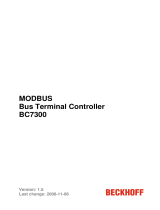 Beckhoff BC7300 User manual
Beckhoff BC7300 User manual
-
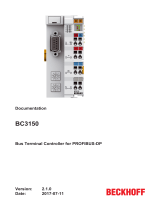 Beckhoff BC3150 Documentation
Beckhoff BC3150 Documentation
-
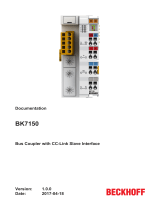 Beckhoff BK7150 Documentation
Beckhoff BK7150 Documentation
-
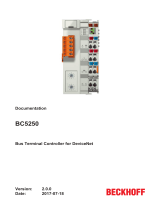 Beckhoff BC5250 Documentation
Beckhoff BC5250 Documentation
-
 Beckhoff BK8000 Technical Documentation Manual
Beckhoff BK8000 Technical Documentation Manual
-
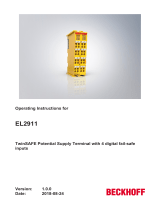 Beckhoff EL2911 Operating Instructions Manual
Beckhoff EL2911 Operating Instructions Manual
-
Beckhoff BC8050 Documentation
-
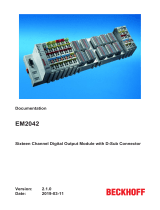 Beckhoff EM2042 Documentation
Beckhoff EM2042 Documentation
-
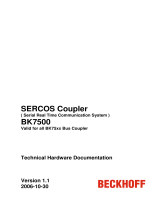 Beckhoff BK75 series Technical Hardware Documentation
Beckhoff BK75 series Technical Hardware Documentation
-
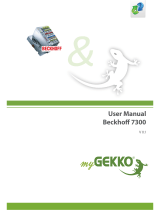 Beckhoff BK7300 User manual
Beckhoff BK7300 User manual
Other documents
-
Pepperl+Fuchs PGV100-F200A-B16-V15 Owner's manual
-
Muvit MUHPH0063 Datasheet
-
JUMO LOGOSCREEN 700 User manual
-
Delta Electronics DVP15MC11T Operating instructions
-
ICP GW-7433D User manual
-
JCM FREE User guide
-
Lenze 3221 C Owner's manual
-
Kollmorgen AKT-PRB-000-000 Installation guide
-
ESAB Profibus I/O Profile - Large Memory Model User manual
-
Lenze AC Tech SC Series Owner's manual





























































































































































